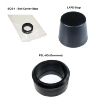Had an interesting find during a Black Friday sale, an older style police baton to add to my collection. It's a very simple design, literally just a cylinder 26" long and 1.25" thick, with no grips, holes or lanyards. It weighs 1.29 lbs, so the density (69.8565 lb/ft3) is roughly that of cocobolo, but my guess is it's synthetic polymer of some kind. The reason I know it's a baton and not a piece of rod stock is the word "Monadnock" written on the side.
Considering it has no grip area, how was this type of baton used? Also, how were they carried if it has no protrusions to sit in a ring?

Considering it has no grip area, how was this type of baton used? Also, how were they carried if it has no protrusions to sit in a ring?




